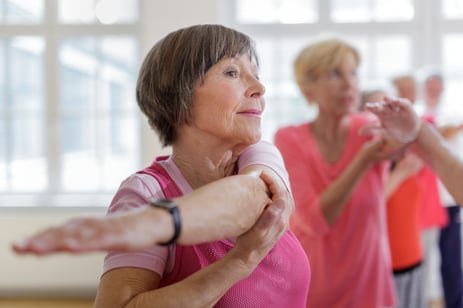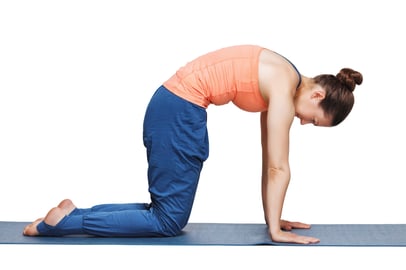At the core of any great fitness program is the belief progress is possible at any age, and this year two of our dedicated team members brought this belief to life for their residents in Arizona with the launch of their Superpowers program. The superpowers program was designed to spotlight the strength and flexibility gains residents can achieve with the right tools, guidance, and encouragement. They set out to empower residents to discover their inner superpower through intentional training, and their outcomes were extraordinary.
Strength Superpowers:
Fitness Specialist Kiona Garza led the strength portion of the superpowers program. Kiona said “it has been a goal of mine to educate our residents about progressive overload and how the body can better adapt to gaining strength through it.” She added, “I know residents get comfortable with the weights they use but if they were to keep using the same weights they would become ineffective at helping them build strength”.
Kiona’s strength program was split into 3 phases: muscular endurance, hypertrophy, and strength. Using the leg press for their 3-rep max test, residents were challenged to increase their strength by at least 25% in two months. Every single one of her participants exceeded that goal and some even achieved as much as a 200% increase in strength.

One resident, Garret W., is a standout. Starting the program with a 115 pound 3-rep max, Garrett increased to 210 pounds which was an impressive 82.6% gain. He had a goal to get stronger for his trip to Israel to celebrate his 90th birthday, and not only did he meet that goal he exceeded expectations by navigating hills, rocky terrain, and stairs with ease. His tour guide was so impressed noting that he had never seen someone Garrett's age move with such agility and independence. Garrett is living proof that age is just a number when it comes to strength.
Flexibility: The Hidden Superpower
 Flexibility is often overlooked in fitness training, but Jabbar Harris another one of our dedicated fitness specialists knew just how powerful it could be. He led the flexibility portion of the superpowers program and guided residents through regular stretching routines designed to safely increase their range of motion, and comfort. One of his participants, Olivia Q., experienced dramatic improvements going from four inches short of her toes to reaching two inches past them - that's a 150% increase in flexibility! She shared with Jabbar that performing the stretches most days of the week not only improved her flexibility but also alleviated soreness in her lower back! Olivia's lower back discomfort went from a self reported “seven” to a “three”. Since completing the Superpowers program, Olivia has continued to incorporate stretching into her daily routine to maintain her new superpower.
Flexibility is often overlooked in fitness training, but Jabbar Harris another one of our dedicated fitness specialists knew just how powerful it could be. He led the flexibility portion of the superpowers program and guided residents through regular stretching routines designed to safely increase their range of motion, and comfort. One of his participants, Olivia Q., experienced dramatic improvements going from four inches short of her toes to reaching two inches past them - that's a 150% increase in flexibility! She shared with Jabbar that performing the stretches most days of the week not only improved her flexibility but also alleviated soreness in her lower back! Olivia's lower back discomfort went from a self reported “seven” to a “three”. Since completing the Superpowers program, Olivia has continued to incorporate stretching into her daily routine to maintain her new superpower.
The superpowers program wasn't about magic, it was about movement, mindset and momentum. This program truly helped the residents we serve realize that strength isn't reserved for the young, and flexibility isn't lost with age. Through education, encouragement, and personalized programming our fitness staff empowered residents to unlock their potential. To Kiona and Jabbar: thank you for your thoughtfulness and dedication to helping the residents that we serve discover just how powerful they are!


 ‘’I am so stiff”. This is a statement heard quite often. More than likely, that stiffness or any type of unknown muscle pain may be result due to the lack of muscular flexibility. Flexibility is crucial in preventing muscle shortening while maintaining muscle length. Some additional benefits of flexibility are improved posture, physical performance, and strength. Stretching does not have to be done before or after an intense work out but should be incorporated within our everyday routine. If our muscles are warm, stretching can be done. I’d suggest immediately after a warm shower. Be sure to be grab a chair also. Yes, you can obtain the same results without being in a standing position.
‘’I am so stiff”. This is a statement heard quite often. More than likely, that stiffness or any type of unknown muscle pain may be result due to the lack of muscular flexibility. Flexibility is crucial in preventing muscle shortening while maintaining muscle length. Some additional benefits of flexibility are improved posture, physical performance, and strength. Stretching does not have to be done before or after an intense work out but should be incorporated within our everyday routine. If our muscles are warm, stretching can be done. I’d suggest immediately after a warm shower. Be sure to be grab a chair also. Yes, you can obtain the same results without being in a standing position.
.jpg?width=378&name=Senior%20dancing%20GettyImages-504735537%20(1).jpg)

 After a workout, it’s important to
After a workout, it’s important to 